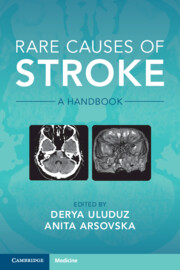Book contents
- Rare Causes of Stroke
- Rare Causes of Stroke
- Copyright page
- Contents
- Contributors
- Preface
- 1 Inflammatory Conditions
- 2 Infectious and Postinfectious Vasculitis
- 3 Hypercoagulable Causes of Stroke
- 4 Drug-Related Stroke
- Chapter 4.1 Medication-Related Stroke
- Chapter 4.2 Illicit-Drug-Related Stroke
- 5 Hereditary and Genetic Causes of Stroke
- 6 Rare Causes of Cardioembolism
- 7 Vasospastic Conditions and Other Vasculopathies
- 8 Other Non-inflammatory Vasculopathies
- 9 Venous Occlusive Conditions
- 10 Bone Disorders and Stroke
- Index
- References
Chapter 4.2 - Illicit-Drug-Related Stroke
from 4 - Drug-Related Stroke
Published online by Cambridge University Press: 06 October 2022
- Rare Causes of Stroke
- Rare Causes of Stroke
- Copyright page
- Contents
- Contributors
- Preface
- 1 Inflammatory Conditions
- 2 Infectious and Postinfectious Vasculitis
- 3 Hypercoagulable Causes of Stroke
- 4 Drug-Related Stroke
- Chapter 4.1 Medication-Related Stroke
- Chapter 4.2 Illicit-Drug-Related Stroke
- 5 Hereditary and Genetic Causes of Stroke
- 6 Rare Causes of Cardioembolism
- 7 Vasospastic Conditions and Other Vasculopathies
- 8 Other Non-inflammatory Vasculopathies
- 9 Venous Occlusive Conditions
- 10 Bone Disorders and Stroke
- Index
- References
Summary
Cerebrovascular disorders, contribute to the morbidity and disability associated with illicit drug use, which may be the most common predisposing condition for stroke among patients under 35 years of age. We present the case of young man with multiple illicit drug addiction and no other vascular risk factors, who presented with acute ischemic stroke and complex cardiovascular etiopathogenic mechanism. We summarize stroke mechanisms by illicit drug and stroke type and suggestion for the management of these challenging cases
Keywords
- Type
- Chapter
- Information
- Rare Causes of StrokeA Handbook, pp. 190 - 198Publisher: Cambridge University PressPrint publication year: 2022



